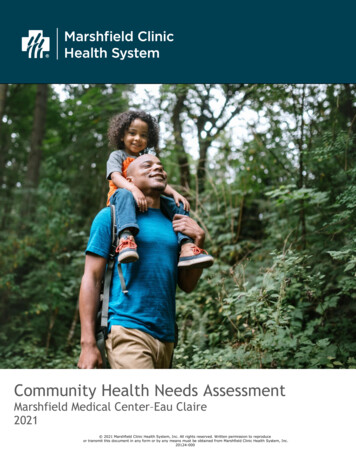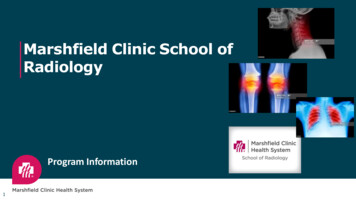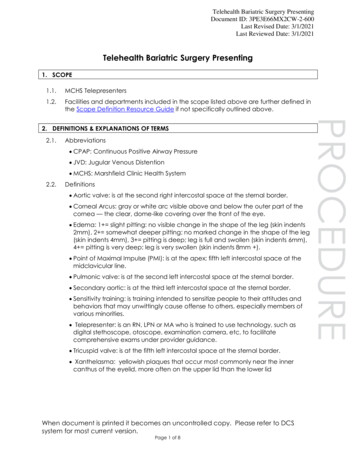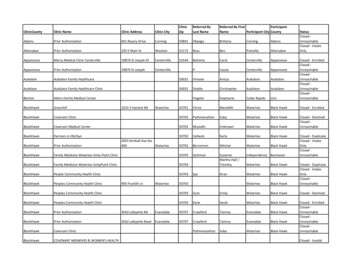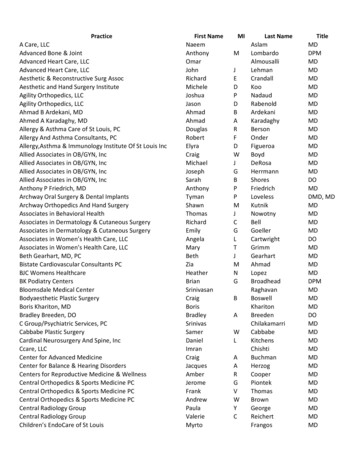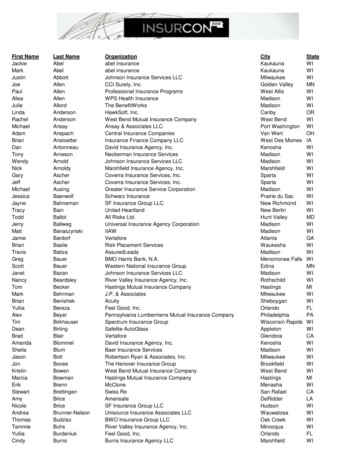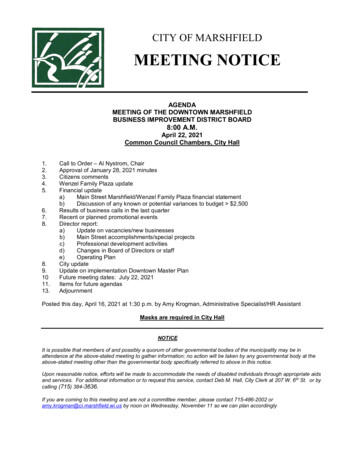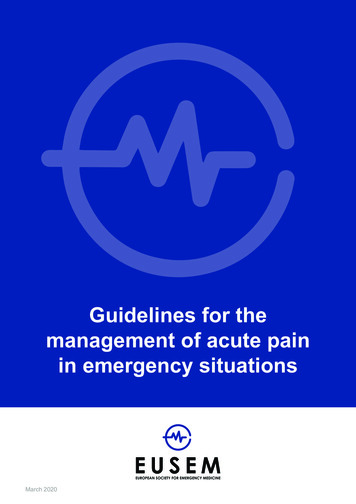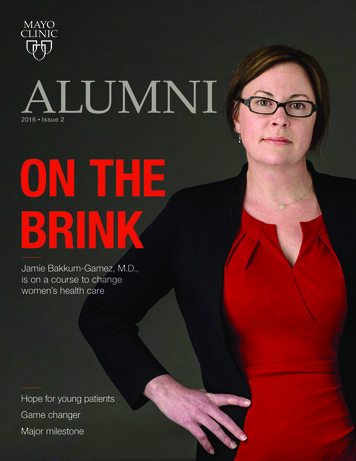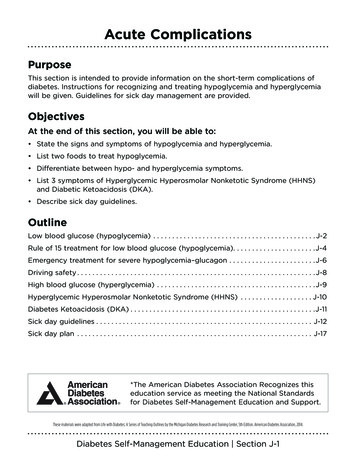
Transcription
Acute ComplicationsPurposeThis section is intended to provide information on the short-term complications ofdiabetes. Instructions for recognizing and treating hypoglycemia and hyperglycemiawill be given. Guidelines for sick day management are provided.ObjectivesAt the end of this section, you will be able to: State the signs and symptoms of hypoglycemia and hyperglycemia. List two foods to treat hypoglycemia. Differentiate between hypo- and hyperglycemia symptoms. List 3 symptoms of Hyperglycemic Hyperosmolar Nonketotic Syndrome (HHNS)and Diabetic Ketoacidosis (DKA). Describe sick day guidelines.OutlineLow blood glucose (hypoglycemia). . . . . . . . . . . . . . . . . . . . . . . . . . . . . . . . . . . . . . . . . . . J-2Rule of 15 treatment for low blood glucose (hypoglycemia). . . . . . . . . . . . . . . . . . . . . . J-4Emergency treatment for severe hypoglycemia–glucagon. . . . . . . . . . . . . . . . . . . . . . . J-6Driving safety. . . . . . . . . . . . . . . . . . . . . . . . . . . . . . . . . . . . . . . . . . . . . . . . . . . . . . . . . . . . . . . J-8High blood glucose (hyperglycemia). . . . . . . . . . . . . . . . . . . . . . . . . . . . . . . . . . . . . . . . . . J-9Hyperglycemic Hyperosmolar Nonketotic Syndrome (HHNS) . . . . . . . . . . . . . . . . . . . J-10Diabetes Ketoacidosis (DKA). . . . . . . . . . . . . . . . . . . . . . . . . . . . . . . . . . . . . . . . . . . . . . . . . J-11Sick day guidelines. . . . . . . . . . . . . . . . . . . . . . . . . . . . . . . . . . . . . . . . . . . . . . . . . . . . . . . . . . J-12Sick day plan . . . . . . . . . . . . . . . . . . . . . . . . . . . . . . . . . . . . . . . . . . . . . . . . . . . . . . . . . . . . . . . J-17*The American Diabetes Association Recognizes thiseducation service as meeting the National Standardsfor Diabetes Self-Management Education and Support.These materials were adapted from Life with Diabetes: A Series of Teaching Outlines by the Michigan Diabetes Research and Training Center, 5th Edition. American Diabetes Association, 2014.Diabetes Self-Management Education Section J-1
Low blood glucose (hypoglycemia)Hypoglycemia or low blood glucose is a side effect of using insulin or certain diabetespills. It is expected that people who use insulin or certain diabetes related medicineswould sometimes have hypoglycemia. It is important you know how to treat hypoglycemia.Safety tips Tell your family and friends about hypoglycemia; tell them the signs and symptoms Tell them how to treat hypoglycemia; they can often spot hypoglycemia soonerthan you can Wear a medical ID tag (a variety of styles are available, check with your pharmacyor internet resources (Appendix-7)Most frequent causes of hypoglycemia Ate too little food Ate less carbohydrate than usual Delayed or skipped meals or snacks Increased activity/work Took too much insulin or diabetesrelated medicines Took insulin or diabetes related medicinesoff scheduleIf your blood glucose level is low, you may have one or more of the following symptoms.Early Warning SignsLate Warning SignsExtreme hungerBlurred visionShakiness, weaknessHeadache, suddenNervousnessAbnormal behaviorLightheadednessInability to concentrateSweatingSleep disturbanceTremorsTingling or numbness (pins and needle sensation)Cold, clammy skinDrowsinessRestlessnessFast heartbeatAnxietyDiabetes Self-Management Education Section J-2
These are the very late signs of low blood glucose levels Slurred speech Confusion or disorientation (“mixed up”) Passing out or unconsciousness Seizures DeathFalse hypoglycemia“I feel like I am having low blood glucose, but the meter reads normal”.False hypoglycemia is having the symptoms of hypoglycemia when your bloodglucose levels are in normal range or even above normal range.False hypoglycemia may occur in: People with newly diagnosed diabetes whose blood glucose was significantlyabove normal, and is now lower People, previously diagnosed with diabetes, with repeated high blood glucoselevels, who now are experiencing improved glucose controlWhen treatment for the high blood glucose is started, blood glucose may return tonormal ranges rapidly. Even though the blood glucose levels are near the normal range,the body feels this level is too low and will present the signs and symptoms of hypoglycemia.These are not true symptoms of hypoglycemia and are not dangerous to the body.Treatment for false hypoglycemia Wash your hands in warm, soapy water and monitor your blood glucose. If the blood glucose is in the normal range or higher, try to tolerate the symptomsrather than eating; if possible rest for a while and the symptoms should pass. Try not to drink anything other than a glass of water or a sugar-free beverage; ifthis does not work and the symptoms are intolerable, try eating a raw vegetable(carrots, celery) or use a minimum amount of simple carbohydrate such as onesmall piece of hard candy or a single glucose tablet. If the blood glucose is less than 70 mg/dl, follow the Rule of 15 for treating hypoglycemia.Diabetes Self-Management Education Section J-3
Rule of 15 – Treatment for low blood glucose (hypoglycemia)Monitor your blood glucose if you are feeling any of the symptoms of hypoglycemia.If your blood glucose is between 50 – 70 mg/dl:1. Eat 15 grams of fast acting carbohydrate.2.Wait 15 minutes and recheck your blood glucose.3. If your blood glucose is still below 70 mg/dl, eat an additional 15 grams of fastacting carbohydrate.4.Recheck your blood glucose again in 15 minutes.5. If your blood glucose is still below 70 mg/dl, repeat steps 3 and 4 until bloodglucose returns to normal levels.If your blood glucose is less than 50 mg/dl:1.Eat 30 grams of fast acting carbohydrates.2.Wait 15 minutes and recheck your blood glucose.3. If your blood glucose is still less than 70 mg/dl, eat an additional 15 grams of fastacting carbohydrate.4. Recheck your blood glucose again in 15 minutes.5. If still below 70 mg/dl, repeat steps 3 and 4 until blood glucose levels return tonormal (more than 70 mg/dl).Special note: Persons with severe hypoglycemia who are able to swallow food withoutrisk of choking may be talked into drinking juice or regular soda. If there is a risk ofchoking, use the glucagon kit. (See page J-8)Foods Providing 15 Grams of Fast-acting CarbohydratesFoodAmountGlucose tabs4 tabletsGlucose gel1 tubeGlucose liquid2 ouncesLow fat or non fat milk1 cupCranberry or grape juice⅓ cupOrange juice½ cupRegular soda½ cupLifesavers 6 – 8 piecesSugar, honey, syrup1 tablespoonDiabetes Self-Management Education Section J-4
When your blood glucose has returned to normal1. If no snack or meal is scheduled for the next hour, eat a small snack(example: ½ sandwich or 5 to 6 crackers with peanut butter).2.Make notes in your blood glucose record such as:a. Time of occurrenceb. Symptomsc. Treatmentd. Possible cause3. About 15 minutes after recovery, monitor your blood glucose to determine if it ismore than 70 mg/dl; if not repeat the treatment for hypoglycemia.4. If the hypoglycemia episode is mild, it is generally safe to resume normal activitysoon after treatment is completed.10. If the hypoglycemia episode was more significant, it may not be safe to dopotentially risky activities, such as driving, for up to 90 minutes after recovery.Poor food choices to treat hypoglycemiaIf at all possible, avoid using complex carbohydrate sources to treat hypoglycemia;especially those containing fat. The carbohydrates in these foods will raise yourblood glucose, but at a slower rate, making recovery time longer. Ice cream Chocolate Doughnuts Milkshakes Pies Cookies Candy bars Cakes Cookie dough Cheese Nuts Pizza Meat Peanut butterSpecial notes Frequent hypoglycemia: If you have 2 or more episodes of mild hypoglycemia in1 week call, your health care provider. Call if the frequency of mild or moderate hypoglycemia increases. Call if you cansee a pattern developing, for example always after exercise, always in the middleof the night. Severe hypoglycemia: Can you treat yourself or does someone need to help you?Severe hypoglycemia means you need another person to treat your low bloodglucose. Call immediately if you have ANY episodes of severe hypoglycemia. Safety: Be sure to carry a fast acting source of carbohydrate with you at all times,if you use diabetes related medicines or insulin.Diabetes Self-Management Education Section J-5
Emergency treatment for severe hypoglycemia – Glucagon Glucagon is an emergency medicine someone else will need to give you; family,friends, and co-workers need to know how to mix and inject glucagon before youneed it; make sure they know where your glucagon kit is stored. Use if a person is having a severe insulin reaction (hypoglycemia) or is in a comaand is unable to take sugar by mouth. The injection of this medicine will increase the blood glucose level. A prescription is needed to buy glucagon. Ask your health care provider for correct dose or amount of glucagon you shouldtake; make sure others are familiar with mixing glucagon and how much to give.General directions for useInstructions need to be followed carefully. See package insert for directions specificto the glucagon kit you are using.1. Using your fingertip, pop the flip-off seal on the glucagon bottle.2.Remove the needle protector or cap from the needle on the syringe.3.Plunge the needle into the rubber stopper on the glucagon bottle.4. Inject the entire contents of the syringe into the bottle. Do not remove theplastic clip from the syringe. (This prevents the plunger from pulling out.)5.Remove the needle from the bottle.6. Gently swirl the bottle until the solution is clear and water-like consistency.The glucagon should not be used unless the solution is clear.7. Using the same syringe, insert the syringe into the glucagon bottle and gentlypull down on the plunger, withdrawing the correct dose of medicine. Afterdissolving the glucagon, the medicine needs to be used immediately.8.Check with your health care provider for your specific dose. Adult: 1 mg (1 unit) Children weighing less than 44 pounds, give ½ the adult dose (0.5 mg)9.I nject glucagon immediately. Into a large muscle such as buttock, thigh, or arm.Injecting into a muscle gives a more rapid response than injecting under the skinas you would with insulin. Make sure the entire dose is given.10. Withdraw the needle and apply light pressure with an alcohol pad at theinjection site.Diabetes Self-Management Education Section J-6
After glucagon is injected and the person is unconscious Make sure the person is breathing and has a pulse (heart beat). Turn them on their side, left is preferred, in case of nausea or vomiting. If the person does not awaken within 15 minutes call 911 and recheck the bloodglucose; a second glucagon injection can be given if necessary.After glucagon is injected and the person is awake Feed the person as soon as they are able to swallow; give them a fast-acting sourceof sugar (i.e., regular soft drink/pop or fruit juice); then give them a long-actingcarbohydrate and protein source (i.e., crackers and cheese or a meat sandwich). Notify the person’s health care provider promptly of the situation. When you have had a severe low blood glucose reaction, you are at an increasedrisk of having another.Over the next 24 hours Monitor your blood glucose often; it is recommended you test every 2 to 4 hoursover the next several hours to detect reoccurring hypoglycemia or hyperglycemiafrom over treatment. Follow your meal plan. Follow your medicine schedule, unless your health care provider tells you otherwise. If any signs of low blood glucose appear, check your blood, and treat immediatelyas needed.If you have used glucagon, notify your health care provider. They may want toadjust your treatment plan.Points to rememberStorage Store the kit at room temperature (68 to 77 F). Never leave glucagon in direct sunlight. Discard any unused portion of mixed glucagon.Expiration date/replacement Check expiration date and replace kit if expired. Use the expired kits to practice mixing technique before discarding. Write the expiration date on your calendar. Replace expired or used glucagon kits as soon as possible.Diabetes Self-Management Education Section J-7
Driving safetySafe driving requires focus,attention, and the ability tomake quick decisions andresponses. Certain diabetesmedicines can cause yourblood glucose to go too low(hypoglycemia). This low bloodglucose can interfere withyour ability to drive safely.If you are taking any of thefollowing medicines or anycombination including theseoral medicines, you are at riskfor hypoglycemia while driving: Insulin Glyburide Glucovance Glipizide (Glucotrol ) Symlin Glimepiride (Amaryl ) Prandin , Starlix If you are taking any of these medicines, there are a few simple guidelines to followto ensure safety on the road. Monitor your blood glucose before you start driving. If your blood glucose is lessthan 70 mg/dl, Do Not Drive. Eat a snack and do not drive until your blood glucoseis above 90 mg/dl and you can focus and have normal response times. If your blood glucose is between 70 and 90 mg/dl, eat 15 grams of carbohydrate(1 carb choice such as a piece of fruit, glass of milk, or 6 saltine crackers) before driving. Have your glucose meter with you when driving. While driving, if you feel as ifyour blood glucose is dropping, pull over immediately. Monitor your blood glucose.If your blood glucose is below 70, treat yourself with 15 grams of fast-actingglucose such as glucose gel or glucose tabs. Do not resume driving until yoursymptoms have stopped and your blood glucose is above 90. Always have a food emergency kit in the car. This should include sources of fastacting glucose such as honey, hard candy, sugar, glucose tabs, or gel. The fooditems of this kit may need to change with the seasons to prevent freezing or melting. Plan travel time around meals or snacks when possible. Try to maintain your usualmeal/snack time patterns. This may require you to stop for a meal or to carry somefoods with you. When making long trips, plan to stop to monitor your blood glucose on a regularschedule. You may find your blood glucose levels are dropping without the usual symptoms. Wear medical identification that lets others know you have diabetes.Diabetes Self-Management Education Section J-8
Obtaining and renewing your driver’s licenseRegulations will vary from state to state. If you have progressive eye disease, such asdiabetic retinopathy, you may be required to submit vision reports before you renewyour license. To prevent delays in renewing your license, plan for the appropriate tests/examination to be completed. Allow enough time for your doctor to complete theseforms and return them to you. More information regarding this can be found on theinternet (www.wisc.gov) or by calling the Department of Transportation/Division ofMotor Vehicles.High blood glucose (hyperglycemia)Signs and symptomsIf your blood glucose level is high, you may experience one or more of the following: Feeling very thirsty Frequent urination Urinating more at night Feeling tired or weak Blurred vision Increased appetite Dry itchy skin Frequent infections that are difficult to heal or clear up Unexplained weight lossWhat to do if you are having signs or symptoms of hyperglycemia To help limit the dehydration caused by high blood glucose, remember to drinkmore sugar-free, caffeine-free liquids. You will need to contact your diabetes team for specific insulin/medicine directions. Watch for signs like nausea and vomiting, confusion, dizziness, abdominal pain,flushed, dry skin, or sleepiness. These are signs of a worsening condition.Prolonged high blood glucose (hyperglycemia) can lead to 2 types of acute crisis:diabetic ketoacidosis (DKA) or hyperosmolar hyperglycemic state (HHNS). Bothof these can be life threatening and may result in altered mental state, loss ofconsciousness or possible coma and death.Diabetes Self-Management Education Section J-9
Hyperglycemic Hyperosmolar Nonketotic Syndrome (HHNS)Symptoms of HHNS are sometimes overlooked or confused with other illnessesor conditions. It is important to recognize the symptoms early and seek medicalattention promptly.Signs and symptoms Dry parched mouth Usually occurs with type 2 diabetes Extreme thirst Occurs when the blood glucose levelsgo higher and higher Confusion Sleepiness Dry, warm skin (no sweating) High blood glucose – call your healthcare provider if your blood glucose ismore than 200 mg/dl higher than yourusual blood glucose level Urine amounts increase (or you needto use the bathroom more often) Dehydration sets in; may go on fordays or weeks Severe dehydration can causeconfusion, seizures, coma, and death If your blood glucose level is over500 mg/dl, have someone take youto the nearest emergency departmentimmediately or call an ambulanceSituations that can increase risk of HHNS Medicines like glucocorticoids (steroids, prednisone), Cimetidine (Tagamet ),beta blockers (Inderal ), diuretics (“water pills”), and phenytoin (Dilantin ) Treatments like intravenous (IV) feedings or peritoneal dialysis where largeamounts of glucose could be used Situations where people are dependent on another person for fluids or areunable to feed themselvesDiabetes Self-Management Education Section J-10
Diabetic Ketoacidosis (DKA)Symptoms of hyperglycemia may be present for several days, but the serious metabolicchanges found with DKA usually occur within a short time and may mimic other diseases.Signs and symptoms Nausea and vomiting Ketones are present in the urine Abdominal pain or cramping Loss of appetite Flushed skin Sweet, fruity odor to the breath Rapid deep breathing Dizziness Passing out or unconsciousness Usually occurs most often in people with type 1 diabetes Diabetic ketoacidosis or DKA occurs when you do not have enough insulin inyour bodyThis is a serious emergency!Diabetes Self-Management Education Section J-11
Sick day guidelinesUse these guidelines when you have a: Minor illness (cold, flu, or upset stomach) Dental procedure (tooth extraction or dental work and can not chew)What you need to do: Monitor and record blood glucose every 4 hours, use a sick day record. Increase monitoring to every 2 hours if other symptoms occur such as:– fever– loss of appetite or nausea– not feeling well Keep taking your diabetes medicine. If you have a fever, drink liquids at least every hour. If you have type 1 diabetes, test your urine for ketones if your blood glucose level isover 240 mg/dl. If you notice any changes in your blood glucose level from yournormal pattern, follow any special guidelines you have from your health careprovider.Call your health care provider if you notice any of the following: Rising ketone levels (type 1 diabetes) Ketones for more than 12 hours (type 1 diabetes) Blood glucose levels greater than 300 mg/dl on two consecutive checks(one after another) Vomiting and/or other unusual symptoms High (101.5 F) or rising fever Fever for more than 24 hoursWhen you call your health care provider Have your glucose and ketone records with you. Be prepared to report your blood glucose and ketone levels, the amount of insulinyou have been taking, your temperature, and the amount of food/fluids you havebeen able to eat.Diabetes Self-Management Education Section J-12
Sick day record (example)TimeFood/Liquids5:30 p.m.½ c water7:30 p.m.½ c reg. soda10:00 p.m.½ c reg. sodaInsulin/Medicine(name& dose)5 Humalog s(fever, nausea,vomiting,dizziness, etc.) 102.4 FNausea Nausea headache Nausea102.8 F If you cannot reach your health care provider, go to the nearest emergency department.Do not wait. Call for help if you are alone and unable to care for yourself.Taking diabetes medicine when you are sick Do not omit your insulin, if you take insulin, take your usual dose when you are sick;call your diabetes team if you have any questions about this. If you take diabetes related medicines, take your usual dose; the stress of being sickraises your blood glucose levels even if you are not eating; this is why it is importantto check your glucose (and your ketone levels if you have type 1 diabetes).What to eat when you are sick When you are ill, it is important to eat the same amount of carbohydrates younormally do; if possible, follow your regular meal plan. It is also important to maintain hydration, drink at least 8 ounces of sugar-free,caffeine-free liquids each hour while awake.– Sugar-free, caffeine-free soda– Water– Broth– Sugar-free Kool-Aid – Herbal teas– Decaffeinated coffee– Sugar-free Jello – Sugar-free Popsicles Diabetes Self-Management Education Section J-13
If you have had nausea and/or vomiting, start with clear caffeine-free liquids– Clear liquids are fluids you can see through; this would include broth, regularsoft drinks, Jell-O , apple or grape juice, and Popsicles .– If your blood glucose levels are higher than 240 mg/dl, drink sugar-free,caffeine-free liquids; you may need to take extra insulin; contact your health careprovider to get instructions if you do not have guidelines.– Space the liquids throughout the day; start with sips every 10 to 15 minutes andgradually increase in volume as tolerated; when you have an upset stomach,drinking frequent small sips of liquid can be easier to tolerate than drinkinglarge amounts.– When you can keep clear liquids down, move to full liquids; full liquids includeorange juice, tomato juice, ice cream, and cream soups.– When you are tolerating full liquids, move to soft foods; this includes oatmeal,toast, plain cooked vegetables, applesauce, rice, noodles, and crackers.– If you can not swallow your regular foods, try to eat soft foods; eat soft foodswith the same amount of carbohydrate content as your regular diet. (See page J-20)– Usually soft and liquid carbohydrates are easier to tolerate until your appetite isback to normal.When you are feeling better continue to monitor your blood glucose and ketonesevery 4 hours; do this until you are back to your usual patterns.If you have not been given a sick day plan,talk with your health care provider.Diabetes Self-Management Education Section J-14
Carbohydrate content of liquids and soft foodsAmountCarbohydrategrams peramountApple juice/cider, grapefruit juice, orange juice,pineapple juice½ cup (4 oz)15 gramsCranberry juice, 100% fruit juice blends, grape juice,prune juice⅓ cup15 gramsRegular soda (not diet)½ cup15 gramsPopsicle , regular124 gramsGelatin, regular (Jell-O )½ cup15 gramsCoffee or tea (without sugar or honey)decaffeinated recommended1 cup0 gramsBouillon, broth1 cup0 gramsSoup, thin and broth-based e.g. chicken noodle,chicken vegetable or beef noodle1 cup15 gramsCream soup, made with water1 cup15 gramsCream soup, made with milk1 cup27 gramsMilk, whole, 2%, 1%, skim1 cup12 gramsYogurt, plain nonfat⅔ cup (6 oz)12 gramsYogurt, nonfat or low-fat fruit-flavored Sweetenedwith sugar substitute⅔ cup12 gramsIce cream, regular, light, fat-free, or no-sugar added½ cup15 gramsPudding, sugar-free (made with milk)½ cup15 gramsPudding, regular (made with milk)½ cup30 gramsCooked cereal (oatmeal)½ cup15 gramsHoney, sugar1 teaspoon5 gramsFood itemBased from Choose Your Foods Exchange List for Diabetes, 2014, American Diabetes Association, Inc.Diabetes Self-Management Education Section J-15
Meal examples – 60 grams eachClear Liquid DietAmountCarbohydrateApple juice1 cup (8 oz)30 gramsRegular Jell-O gelatin1 cup (8 oz)30 gramsChicken broth1 cup0 gramsTotalSoft Foods DietAmount60 gramsCarbohydrateGrape juice⅔ cup30 gramsDecaffeinated coffee, black (without sugar)1 cup0 gramsCream soup, made with water1 cup15 gramsPudding, sugar-free (made with low-fat milk)½ cup15 gramsTotal60 gramsWhat do you eat for a meal on a sick day?FoodAmountCarbohydrateTotalDiabetes Self-Management Education Section J-16
Sick day planI should take and do the following, if I haveCold symptomsCoughDiarrheaStomach acheNausea & vomitingHeadacheDo I Change the dose of my medicine:l Yesl NoIf so, which medicine and what changes?Test my blood glucose levels:l Yesl NoHow often?Test my urine for ketones:l Yesl NoHow often?Diabetes Self-Management Education Section J-17
If I can not eat food What should I do if my blood glucose levels are 180 mg/dl or greater?What should I do if my blood glucose levels are 70 mg/dl or below?What kinds of things would be helpful to have available for sick days?NotesWhen should I call my health care provider?Diabetes Self-Management Education Section J-18
Sick day recordDoctor phonePharmacy phoneTimeFood/LiquidsInsulin/Medicine(name& dose)BloodGlucoseUrineKetonesSymptoms(fever, nausea,vomiting,dizziness, etc.)Adapted from Life with Diabetes (3rd edition), 2004, American Diabetes Association, Virginia.Diabetes Self-Management Education Section J-19
Diabetes Self-Management Education Section J-6 Emergency treatment for severe hypoglycemia - Glucagon Glucagon is an emergency medicine someone else will need to give you; family,
